Snow research has found that with adequate fetches, prairie landscapes can lose between 30 and 75% of annual snow water to sublimation. Sublimation losses depend largely on wind speed, fetch length, topography and vegetative features. Vegetative features such as shelterbelts both reduce the fetch and traps snow.
Topographic features such as depressions and ditches also effect snow trapping and distribution. While some features cannot be modified, the placement and spacing of new shelterbelts, that act to reduce the fetch length, can significantly reduce sublimation losses. Total water equivalents for snowfall in the Canadian prairies are in the range of 110 to 150 mm so reduced sublimation losses have positive impacts on crop and tree growth. Snow water also contributes significantly to the recharge of surface and groundwater.
Because zero tillage has resulted in the maintenance of standing stubble, it is often seen as the only practice required to maintain snow on the landscape. However, once the stubble is full, the snow is still subject to drifting and sublimation losses and the use of shelterbelts would effectively conserve additional snow water. There also appears to be some urgency to this work. Many shelterbelts and other vegetative features, on the agricultural landscape, are being removed to make way for an emerging style of agriculture that leads to large and very open fields that are especially conducive to sublimation losses. Our study area was picked because of the abundance of differently spaced shelterbelts, but unfortunately, even as we collected snow data many of the area’s numerous shelterbelts were being removed.

During late February of 2011 our research team collected snow measurements on both the windward and lee side of shelterbelts. These were relatively simple measurements but working on the windy side of the shelterbelts, where it felt like - 300 C (-220 F), did add an additional challenge to the work. Snow depth and snow water equivalent measurements were taken to determine snow water content of fields that were being compared. Three transects, at right angle to the shelterbelts, were sampled to provide reasonable field averages for the snow measurements. Measurement from six different fields with a range of shelterbelt spacings were taken in order to compare the effect of field size on snow water distribution. The narrowest spacing was a 133 m and the widest field had shelterbelts located 800 m apart. Because we estimated the dominant winds blew at a 45o angle to the shelterbelts this resulted in fetch lengths of nearly 200 m and 1200 m.
Part of our 2011 study compared the results of measured snow water distribution to modeled snow distribution. We worked closely with the developer of a widely recognized snow model on this component. Once we were satisfied that the modeled results compared well to our field data we were able to confidently run the snow model with 15 years of actual weather data and with a number of shelterbelt spacings scenarios.
The modeling exercise determined that the greatest sublimation reductions were obtained at shelterbelts more closely spaced. The fields with shelterbelts spaced at 133 m had an average of 12.5 mm lower annual sublimation losses than the no shelterbelt scenario. While these results were less than suggested by other similar studies they are nonetheless significant. This additional moisture would be available during the critical seeding period. The lower than expected sublimation values may be accounted for by the relatively low snow fall levels in the area and stubble heights of 30 cm. Our findings also indicate that low porosity shelterbelts placed at 400 m spacing, though less effective than narrower spacing, did have a positive effect on reducing sublimation losses.
In addition to considering the annual impact of snow water conservation, it could be useful to consider the cumulative impact of more snow water being available. Over the 15 year modeling period the narrow field situations had 59 mm more moisture available than the unsheltered fields.
In addition to conserving snow water there are other snow related benefits associated with maintaining shelterbelts on the landscape: They protect roads and farmyards from snow loading; and by reducing snow drifting and maintaining visibility, roadside shelterbelts improve otherwise hazardous driving conditions.
At a time when equipment is large and farming efficiency is critical, it will be a worthwhile challenge for agroforestry professionals to find shelterbelt configurations that will provide the highest level of snow water conservation and still be workable for the farmer.
Gary Bank and John KortAESB, Agroforestry Development Centre



